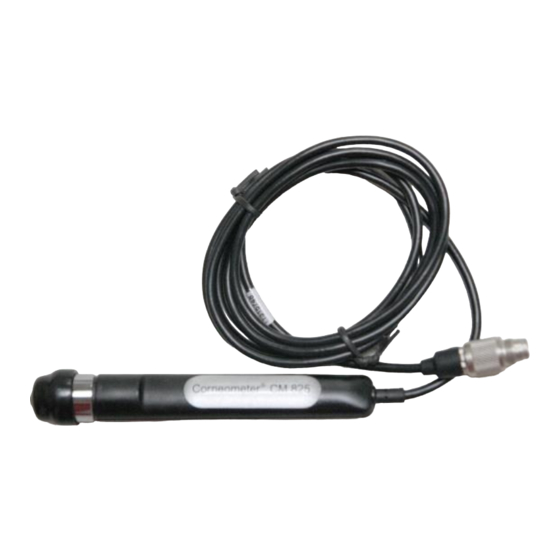
Advertisement
Quick Links
CM - Corneometer
CM 1 – Aim & Audience of this Manual
This manual contains the instructions necessary to work with the probe correctly and
in accordance with its intended use. The manual is meant to be read by the persons
who will be operating the probe.
It is only valid in context with the following instructions:
MPA Hardware and MPA Software or
MDD 4 or
Wireless Hardware and MPA Software
the probe head, separated from the skin by a
glass lamina, build-up an electric field
between the tracks with alternating attraction.
One track builds up a surplus of electrons
(minus charge) the other a lack of electrons
(plus charge). When put on the skin surface,
the scatter field penetrates the very first layer
of the skin. The Corneometer
measures the change in the dielectric
constant due to skin surface hydration
changing the capacitance of a precision
capacitor. The measurement can detect even
slightest changes in the hydration level.
Unlike the impedance measurement no
galvanic relation between the device and the measuring object and no polarization
effects exists.
CM 2.2 - Advantages of the Corneometer
Substances on the skin (e.g. salts or residues of topical applied products) have
only minimal influence due to capacitance measurement.
It allows very quick measurement (1 s) important to avoid occlusion.
Continuous measurements over a longer time period can optionally be
performed.
CM probe English 2019/02 DK
®
CM 825
CM 2 – General Information on the
Measurement
CM 2.1 – Measurement Principle of the
Corneometer
The
measurement
measurement of a dielectric medium, here the Stratum
Corneum, the uppermost layer of the skin. With
increasing hydration, its di-electric properties change.
The measurement is based on the fact that water has
a higher dielectric constant (81) than most other
substances (mainly < 7).
Gold tracks on
top of the in
®
CM 825
®
CM 825
is
based
®
CM 825
on
capacitance
1
Advertisement

Summary of Contents for CM Corneometer CM 825
- Page 1 CM - Corneometer CM 825 CM 1 – Aim & Audience of this Manual This manual contains the instructions necessary to work with the probe correctly and in accordance with its intended use. The manual is meant to be read by the persons who will be operating the probe.
- Page 2 *U. Heinrich, U. Koop, et al.: Multicentre comparison of skin hydration in terms of physical-, physiological- and product- dependent parameters by the capacitance method (Corneometer CM 825), International Journal of Cosmetic Science, 2003, 25, 45-51 2.3 Fields of Application...
- Page 3 USB-connection to the computer. CM 5 – Handling Advice for the Corneometer CM 825 Preparation of the measurement For exact and reproducible measurement values it is important to follow the...
- Page 4 Moisture underlies external and internal influences. Always design a detailed testing protocol and try to keep constant as many factors as possible. CM 6 – Hydration Measurement ® Place the Corneometer -probe head straight on the skin area to be measured according to the pressure of the spring in the probe.
- Page 5 Make sure that it is never hit on hard surfaces. It could damage the sensor or bring it out of calibration. CM 6.1 - Interpretation of the Results The following values are valid for healthy skin and normal room conditions (20 C and...
- Page 6 MDD-devices. CM 7 – Check Calibration Function ® With the Corneometer CM 825 you can check the accuracy and the penetration depth ® of the scatter field anytime quickly and easily. Check your Corneometer CM 825 regularly and always before a mayor study.
- Page 7 Place the probe vertically onto the foil and do not move it during the measurement. In the MPA-software: Press “Start” in the software. 5 measurements are performed one after each other. CM probe English 2019/02 DK...
- Page 8 Corneometer CM 825 probe has a very small penetration depth. The lower value must be around 20 ( 5 CM units), the higher value around 120 ( 5 ® CM units). If this is the case the Corneometer CM 825 works perfectly.
- Page 9 ® Units: arbitrary Corneometer units Dimensions: probe approx. 11 cm long, Weight: approx. 41 g, Measurement head: 49 mm², Cable: approx. 1.30 m Measurement time: 1 s. Frequency: 0.9-1.2 MHz, Pressure: approx. 1 N ± 10%, Accuracy: 3 % Operation conditions –...
Need help?
Do you have a question about the Corneometer CM 825 and is the answer not in the manual?
Questions and answers